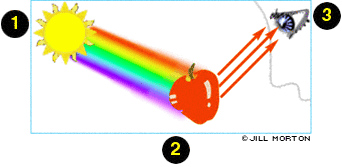EDUC 2220 – Educational Technology Lesson Plan
Colors Visually Seen
Ms. Kisor
K-8 -Science
Common Core Standards:
Socially grouping, communicating, enduring the use of technology with the technology ability of the in class smart board, as well as visually understanding that are eyes and brain put the colors together.
Our previous lesson we discussed how remarkable the eye has the ability to distinguish light to color from the brain to the eyes.

1. All the "invisible" colors of sunlight shine on the apple.
2. The surface of a red apple absorbs all the colored light rays, except for those corresponding to red, and reflects this color to the human eye.
3. The eye receives the reflected red light and sends a message to the brain.
The most technically accurate definition of color is:
"Color is the visual effect that is caused by the spectral composition of the light emitted, transmitted, or reflected by objects
Color Vision
There are two distinct kinds of cells in the eyes, the cones and the rods. The cones are the cells which are responsible for transmitting color vision to the brain. As InnVista explains, there are three different kinds of cones: green absorbing, red absorbing and blue absorbing. Colors are identified in the brain by examining the relative activity of all three kinds of cones. When colored light hits the pigments in the cones, it generates a chemical signal. This signal then causes a small electrical current to develop in the cone cells and some of the other nerve cells in the retina, which is the beginning of transmitting color images to the brain. Cone cells are concentrated in the middle of the retina and are tightly clustered in a special eye region called the fovea.
http://www.livestrong.com/article/83641-eyes-send-images-brain/
Pre-Assessment: What four colors are in a magazine print out?
The class is given flashcards that I printed. I randomly laid the frash cards on their desk. Before they are placed in their color coded groups they need to write down their name and write down what four colors are mostly in a magazine print out.
http://quizlet.com/42340861/what-four-colors-are-mostly-in-a-magazine-print-out-flash-cards/
A group activity that will be used on the SmartBoard
http://www.learner.org/teacherslab/science/light/color/dots/madefromdots_1.html
Peer Review:
This lesson will require the students to grade each others peers last six question written assignment. The color coded groups will not be able to grade any one in their group, as I explain the answers out loud.
|
Instructor: |
Ms. Kisor |
Name: |
|
|
|
|
Date: |
|
|
|
|
Group: |
|
|
|
|
|
|
Read each question; write the letter on the line as well as circle the letter to the correct question. You have thirty minutes to complete all six questions. If you leave #6 blank I will mark your paper at a 0%! I do hope all the groups were able to get the opportunity to enjoy each other’s thoughts, opinions as well as input with one another for this lesson. Any question that is True/False, I need to see written explanation on the back for peer reviewing. Good Luck!
- What other colors do you think are used in a magazine print out?
- In our class discussion, we reviewed a website about individuals that have color blindness, what colors are unable to be seen visually?
- Green, Orange & Yellow
- Blue, Red & Green
- No colors
- How does color exist?
- Color as light
- Vision and Reflection
- All of the above
- Do you think that this lesson related to how our eyes connect to brain activity?
- True
- False
- Did you enjoy the use of the Smart Board for this lesson?
- True
- False
- What are three primary colors that cannot be mixed by other colors?
- Green, Yellow, and Brown
- Red, Blue and Yellow
- All of the above
